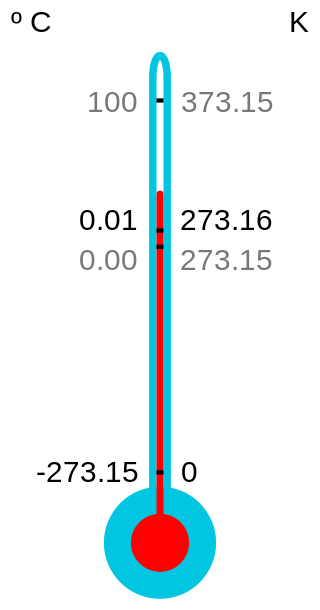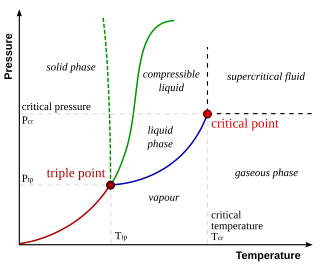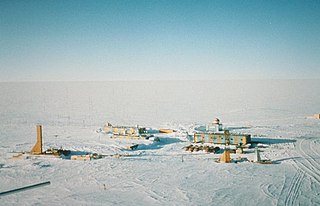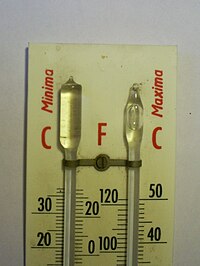
Absolute zero is the lowest limit of the thermodynamic temperature scale; a state at which the enthalpy and entropy of a cooled ideal gas reach their minimum value, taken as zero kelvin. The fundamental particles of nature have minimum vibrational motion, retaining only quantum mechanical, zero-point energy-induced particle motion. The theoretical temperature is determined by extrapolating the ideal gas law; by international agreement, absolute zero is taken as −273.15 degrees on the Celsius scale, which equals −459.67 degrees on the Fahrenheit scale. The corresponding Kelvin and Rankine temperature scales set their zero points at absolute zero by definition.

Daniel Gabriel Fahrenheit FRS was a physicist, inventor, and scientific instrument maker, born in Poland to a family of German extraction. Fahrenheit invented thermometers accurate and consistent enough to allow the comparison of temperature measurements between different observers using different instruments. Fahrenheit is also credited with inventing mercury-in-glass thermometers more accurate and superior to spirit-filled thermometers at the time. The popularity of his thermometers led to the widespread adoption of his Fahrenheit scale attached to his instruments.

In thermodynamics, the triple point of a substance is the temperature and pressure at which the three phases of that substance coexist in thermodynamic equilibrium. It is that temperature and pressure at which the sublimation, fusion, and vaporisation curves meet. For example, the triple point of mercury occurs at a temperature of −38.8 °C (−37.8 °F) and a pressure of 0.165 mPa.

A thermometer is a device that measures temperature or temperature gradient. A thermometer has two important elements: (1) a temperature sensor in which some change occurs with a change in temperature; and (2) some means of converting this change into a numerical value. Thermometers are widely used in technology and industry to monitor processes, in meteorology, in medicine, and in scientific research.

A barometer is a scientific instrument that is used to measure air pressure in a certain environment. Pressure tendency can forecast short term changes in the weather. Many measurements of air pressure are used within surface weather analysis to help find surface troughs, pressure systems and frontal boundaries.
This is a timeline of temperature and pressure measurement technology or the history of temperature measurement and pressure measurement technology.
The following is a timeline of low-temperature technology and cryogenic technology. It also lists important milestones in thermometry, thermodynamics, statistical physics and calorimetry, that were crucial in development of low temperature systems.

The mercury-in-glass or mercury thermometer is a thermometer that uses the thermal expansion and contraction of liquid mercury to indicate the temperature.
A hydrometer or lactometer is an instrument used for measuring density or relative density of liquids based on the concept of buoyancy. They are typically calibrated and graduated with one or more scales such as specific gravity.

The lowest natural temperature ever directly recorded at ground level on Earth is −89.2 °C at the then-Soviet Vostok Station in Antarctica on 21 July 1983 by ground measurements.

A hygrometer is an instrument which measures the humidity of air or some other gas: that is, how much water vapor it contains. Humidity measurement instruments usually rely on measurements of some other quantities such as temperature, pressure, mass and mechanical or electrical changes in a substance as moisture is absorbed. By calibration and calculation, these measured quantities can lead to a measurement of humidity. Modern electronic devices use the temperature of condensation, or they sense changes in electrical capacitance or resistance to measure humidity differences. A crude hygrometer was invented by Leonardo da Vinci in 1480. Major leaps came forward during the 1600s; Francesco Folli invented a more practical version of the device, while Robert Hooke improved a number of meteorological devices including the hygrometer. A more modern version was created by Swiss polymath Johann Heinrich Lambert in 1755. Later, in the year 1783, Swiss physicist and Geologist Horace Bénédict de Saussure invented the first hygrometer using human hair to measure humidity.
This is a list of meteorology topics. The terms relate to meteorology, the interdisciplinary scientific study of the atmosphere that focuses on weather processes and forecasting.
A medical thermometer or clinical thermometer is a device used for measuring the body temperature of a human or other animal. The tip of the thermometer is inserted into the mouth under the tongue, under the armpit, into the rectum via the anus, into the ear, or on the forehead.

The alcohol thermometer or spirit thermometer has a similar construction and theory of operation as a mercury-in-glass thermometer. However, the thermometric fluid of an alcohol thermometer is less toxic and evaporates quickly making it a safer alternative to mercury thermometers. The ethanol version is the most widely used due to the low cost and relatively low hazard posed by the liquid in case of breakage.

Temperature is a physical quantity that quantitatively expresses the attribute of hotness or coldness. Temperature is measured with a thermometer. It reflects the average kinetic energy of the vibrating and colliding atoms making up a substance.

Maria da Fé is a Brazilian municipality located in the state of Minas Gerais. Its population as of 2020 is estimated to be 14,056 people. The area of the municipality is 203.774 km2. The city belongs to the mesoregion South/South-West of Minas Gerais and to the microregion of Itajubá.
ʽAziziya, sometimes spelled El Azizia, is a small town and capital of the Jafara district in northwestern Libya, 41 kilometres (25 mi) southwest of the capital Tripoli. From 1918 to 1922, it was the capital of the Tripolitanian Republic, the first formal republic in the Arab world. Before 2001, it was part of the ʽAziziya District and served as its capital. ʽAziziya is a major trade centre of the Sahel Jeffare plateau, being on a trade route from the coast to the Nafusa Mountains and the Fezzan region to the south. As of 2006, the town's population has been estimated at over 23,399.

Atmospheric temperature is a measure of temperature at different levels of the Earth's atmosphere. It is governed by many factors, including incoming solar radiation, humidity, and altitude. The abbreviation MAAT is often used for Mean Annual Air Temperature of a geographical location.

The Miller–Casella thermometer was a Six's thermometer with a double bulb used extensively by the Challenger expedition during the late nineteenth century. The thermomemeter was used for water temperature readings along 360 different research stations around the world's oceans.
Angelo Bellani (1776–1852) was an Italian priest who also took an interest in physics and is best known for his work in the measurement of temperature and humidity using instruments and his inventions included a temperature recording thermograph. He started a company for producing standardized thermometers.














